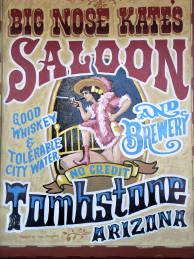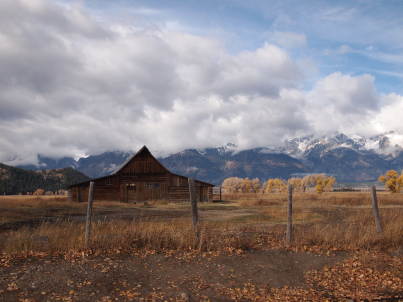On the Cowboy Trail - page four
from Encounters in the US Mountain West; A Sinner amongst the Latter Day Saints, by Ian R. Mitchell - to be published by NWP Publishing in September 2012
 In Tombstone you can be in your own movie, watch re-enactments of the gunfight, dress up as a cowboy, take a ride in a stagecoach and do all those things that Americans do well and with gusto. I limited myself to watching the goings-on from the safe vantage point of the OK Cafe, where I treated myself to a coffee and buffalo burger, before taking a stroll around town whilst others followed the cowboys to the promised shoot out. By 1900 all the silver mines had closed and the population plummeted, but Tombstone survived as an administrative centre for the county. In 1917 the mine owners in neighbouring Bisbee summoned the obedient Sheriff Wheeler from nearby Tombstone to deal with a strike in the copper mines by the IWW. Wheeler deported over 1000 men and dumped them in the desert without food or water, breaking the strike.
In Tombstone you can be in your own movie, watch re-enactments of the gunfight, dress up as a cowboy, take a ride in a stagecoach and do all those things that Americans do well and with gusto. I limited myself to watching the goings-on from the safe vantage point of the OK Cafe, where I treated myself to a coffee and buffalo burger, before taking a stroll around town whilst others followed the cowboys to the promised shoot out. By 1900 all the silver mines had closed and the population plummeted, but Tombstone survived as an administrative centre for the county. In 1917 the mine owners in neighbouring Bisbee summoned the obedient Sheriff Wheeler from nearby Tombstone to deal with a strike in the copper mines by the IWW. Wheeler deported over 1000 men and dumped them in the desert without food or water, breaking the strike.
But there are still cowboys- who handle actual cows - in the West. To find them you have however to go, not south from Utah into Arizona, but north from Utah into Wyoming. The Wyoming state emblem shows a cowboy on a horse and the slogan attached is "Forever West". I was to realise that this was reality, not virtual reality, on the occasion when I headed north from Utah towards the Tetons and the Wind River Mountains of Wyoming. Of course I had read Annie Proulx's Brokeback Mountain and seen the film (up to near the end when I left knowing what was coming). But that was set back in the 1950s, and anyway, they were shepherds, not cowboys, I recalled. Even when I was told by a friend in Salt Lake City,
"Take care up there. A guy was lynched for being gay in Laramie last year." - I did not baulk, there must, I thought, have been some mistake in the reporting of that event. And anyway, I'm not gay, that's obvious, I confidently told myself.
The way north lay through Idaho, and I half expected to be driving past the houses of maniacs with tanks in their front gardens, armed to the teeth and waiting for Armageddon - or for the Devil in the guise of the US Taxman. But those types are apparently further up north, in the Panhandle area, down south there appeared to be nothing but docile potato farmers and fruit growers, predominantly Mormons as I saw to my relief. I was headed for the Tetons, partly to do some walking, and partly as it was the location of the filming of one of my favourite westerns Shane. Shane is a man who wants to put his violent past behind him, but events force him to realise that, as the classic all-American avenger and distributor of justice, he can only do it one way. By picking up the gun again, and killing the evil doers, before riding off into the sunset. The scenery in this film, a vista across a wide plain with the Tetons behind, I just could not believe existed. It must be a magnificient stage set of some kind, I had thought on watching the movie. And as I drove northwards, seeing the Tetons from their unflattering, western, Idaho side, I was coming to think this was the case. From Driggs, the range looked a bit like the Cairgorms from Aviemore.
 Leaving Driggs the road through the Teton Pass at over 8,000ft takes you to Jackson, Wyoming. But Jackson is as much Wyoming as Acapulco is Mexico. It is a mega-rich resort, where the billionaires are pushing out the millionaires, and is serviced by thousands of workers who migrate from Idaho over the border each day. It has that Swiss Alpine look that is favoured in US mountain resorts, and I passed through it, not tempted to look around, and on into the Tetons National Park. There are some iconic unforgettable moments in your life, and driving into the park, towards Mt Moran and the Grand Teton, was one of them, it was pure Shane. With the exception of the Caucasus I had not seen mountains so dramatic and so beautiful at the same time. Ever. But I was soon to realise that this was not Shane country, not an area where typical western style isolated homeseads had been established, to be threatened by the wicked cattle barons. Driving through the park I saw a sign pointing to Mormon Row, and followed it to a parking lot where there was an abandoned village. Like Johah trying to escape from the Lord and failing, it seemed like there was no way I could get beyond the reach of the Saints. Had my rationalism been of less stern stuff, I might have thought; is there a message for me from Someone in all of this?
Leaving Driggs the road through the Teton Pass at over 8,000ft takes you to Jackson, Wyoming. But Jackson is as much Wyoming as Acapulco is Mexico. It is a mega-rich resort, where the billionaires are pushing out the millionaires, and is serviced by thousands of workers who migrate from Idaho over the border each day. It has that Swiss Alpine look that is favoured in US mountain resorts, and I passed through it, not tempted to look around, and on into the Tetons National Park. There are some iconic unforgettable moments in your life, and driving into the park, towards Mt Moran and the Grand Teton, was one of them, it was pure Shane. With the exception of the Caucasus I had not seen mountains so dramatic and so beautiful at the same time. Ever. But I was soon to realise that this was not Shane country, not an area where typical western style isolated homeseads had been established, to be threatened by the wicked cattle barons. Driving through the park I saw a sign pointing to Mormon Row, and followed it to a parking lot where there was an abandoned village. Like Johah trying to escape from the Lord and failing, it seemed like there was no way I could get beyond the reach of the Saints. Had my rationalism been of less stern stuff, I might have thought; is there a message for me from Someone in all of this?
Half a dozen families had been sent to colonise Mormon Row in 1889, and they had built a school, a church, a post office and the houses and barns which had subsequently become the icons of the Teton National Park, shown in every postcard and calendar image, against the mountain backdrop. These buildings, though now empty, poignantly remained as did the slowly filling up channels of their irrigation systems and the rusting remains of agricultural machinery. But the community struggled in the harsh terrain, and those remaining were evicted in the 1930s by the park authorities, intent on restoring a pristine environment, an then filling that up with log cabins, lodges and visitor centres. The same happened in Appallachia where the hill-billies were expelled, their abandoned illicit distilling locations becoming Visitor Attractions, and in Yosemite where the native Americans were kicked out, and then, washed and sanitised, returned to people a virtual reality "Native Village" for tourist amusement. Maybe one day we will see people back in Mormon Row pretending to be LDS settlers.
There are no easy peaks in the Tetons, and the time when I might have challenged their summits to a duel are long past, but I was here to spend a couple of days walking in their innards, to pay homage to them. My first day's target was Lake Solitude, and it was necessary to take a boat across Jenny Lake, and then hike up Cascade Creek. The boat was full of enthusiastic Americans - and a Bulgarian. It could have been that I was missing European cultural references, or it could have been that she was young and pretty, but we got into conversation. She seemed awed at my day's walking target, but declined my offer to be her guide and take her along. She was a mechanical engineer who had left Bulgaria, whose economy was still in chaos twenty years after the so-called Collapse of Communism, and had come to the States to work. Maybe I overdid the economic/ social analysis bit and lost her interest (this tends to happen to me with women, I have noticed) but anyway she went with the rest of the Merkans, about a quarter of a mile to Inspiration Point, to be "inspired", then waited for the next boat back. I headed up the canyon.
It was September and the canyon was in the full bloom of autumn, with raspberries, huckleberries and whortleberries hanging on the bushes. The lower canyon was deeply wooded and on emerging into thinner forest the full impact of the Cathedral Group of mountains- The Grand Teton, Mount Owen, and Mount Teewinot- was felt, their sides hung with small snowfields and glaciers. Half way up the trail there was a fine waterfall and an unoccupied ranger station and then a steep climb of about 2,000 ft to Lake Solitude. My guidebook assured me there would be no solitude there but lots of people, though in fact I was the only person who had come this far. Mindful that the last boat was at six o'clock, I began racing back down the track. This is not a good idea in these parts, as there are bears around, but it wasn't a bear I met when crashing through the forest. It was a very large Bull Moose which looked at me in what I construed to be a displeased fashion. Moose actually kill many more people than bears do, attacking trampling and goring them, so I froze and waited to see what he would do. With a look that seemed one of utter contempt, he ambled off into the forest.
I made the boat with time to spare, and then had to find somewhere to stay for the night. As accommodation inside the park consists of camping and RV units, that was out (no RV, no tent), and I thought Jackson would be beyond my budget so I consulted the map and headed south-east for a place called Dubois, threatening to veer off the road as I drove, through checking images of the Tetons in my mirrors when they emerged. There were surprisingly few if any signs of tourism along this road; maybe the visitors didn't come in this way, I thought? Finally I found a petrol station and shop with cabins attached, and pulled in for the night. Once again in America I found myself in the position, which I have failed to satisfactorily explain, of being the only person in a place. I nearly turned back out when they guy said.
"Its $60 for a night, provide your own bedding. Breakfast extra."
I had a sleeping bag borrowed from Mikel, I had my packet of biscuits as the place offered no evening food (and that provided in the morning was inedible) But it was worth it, for what must be the best view of the Tetons from anywhere; I sat and marvelled till the bugs drove me inside as the night fell.
Next day it was back to the park and leaving Lupine Meadows I decided to head for Amphitheatre Lake and as far past that point as I could get. The track went up through the forest on some quite punishing zig-zags, and this time there were a few other people on the trail. As the path rose we passed fine waterfalls with occasional views of the summits, including that of the Grand Teton at 13,770 ft. Eventually I reached Surprise Lake and a little beyond it Amphitheatre Lake at 9700ft. The trail ended here and so did most people's hike. (Americans don't generally like going off-trail) But there was a scree slope to a higher saddle where I thought I might get a better view, so I scrambled up and then a little onto the nose of Disappointment Peak to about 10,000 ft. This was a disappointment, as the Grand Teton remained hidden behind its bulk.
Back at the saddle I met a father and son who were having lunch and I joined them; the older man recommended the Pinnacle beside Surprise Lake for the best view of the Grand, and I subsequently took his advice, which was good advice, on my way back. Though very eroded, with a wee tricky bit, the ascent repaid the effort. Before I departed to do that, he asked, as they do Whereyafrom? "Scotland?" he noted, "Not very popular with a lotta folks over here these days."
"No, but we are very popular in Libya," I retorted. Megrahi, reputedly the Lockerbie bomber had just been released on humanitarian grounds from a Scottish jail. He asked me if I thought Megrahi was really at death's door, the reason given for his release.
"I don't know, but that's not the point. The point is, he didn't do it, as everybody in the UK knows. Even some of the relatives of the victims have been campaigning for his release. He was freed to avoid a judicial inquiry into the case, which would have shown he was innocent."
My new found friend listened, and commented,
"Well, we haven't heard anything about that in the US."
Well, with Fox News, they wouldn't, would they? I suggested he try googling some internet websites on Lockerbie to get more information, and he said he would. Maybe he did.
on
Continue reading On the Cowboy Trail
from Encounters in the US Mountain West; A Sinner amongst the Latter Day Saints, by Ian R. Mitchell - to be published by NWP Publishing in September 2012







